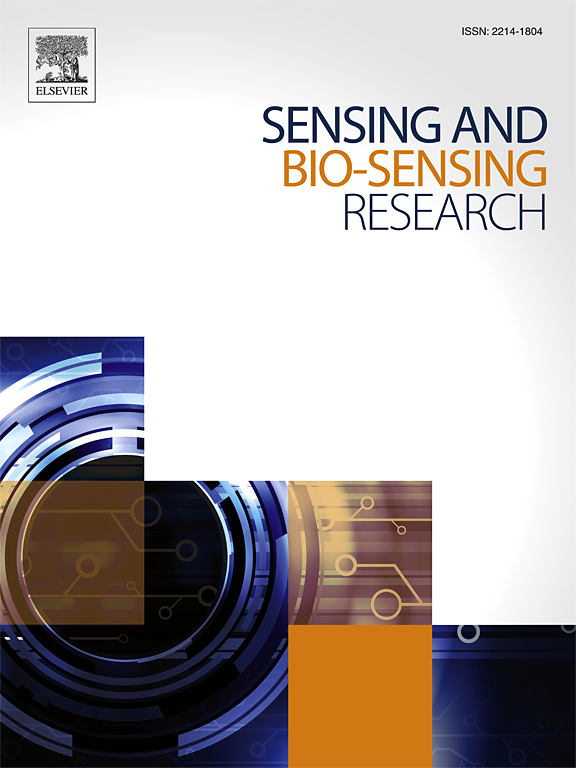直接燃料电池中基于钼酸锌纳米结构乙醇电氧化的能效提高
IF 4.9
Q1 CHEMISTRY, ANALYTICAL
引用次数: 0
摘要
今天,环境污染和能源短缺已经成为世界未来面临的两大危机。此外,利用声化学方法合成新型纳米结构由于其无毒性和环境友好性是一个很有前途的选择。本文采用声化学方法合成了具有不同前驱体的新型钼酸锌纳米粉体。以钼酸锌钠和不同的锌盐如硝酸锌、醋酸锌和硫酸锌为前驱体,进行了纳米结构的合成。同时,利用声化学方法优化了超声功率和时间辐照等因素对纳米结构合成的影响。通过场发射扫描电镜(FESEM)、傅里叶变换红外光谱(FTIR)、x射线衍射(XRD)和能量色散x射线光谱(EDX)等多种技术对产物进行了表征。结果表明,在优化条件下,硝酸锌前驱体可以制备出均匀的纳米结构。因此,将纳米结构的钼酸锌化合物应用于碳糊电极的改性。以乙醇氧化反应为实验对象,研究了纳米结构修饰电极的电催化性能。采用循环伏安法(CV)和计时安培法进行了电化学表征以及稳定性和重复性研究。纳米结构修饰电极对乙醇氧化的催化性能优于CPE。因此,纳米结构在未来的工作中具有潜在的应用和发展方向。该修饰电极在燃料电池、传感器和储能领域的潜在应用可以被考虑,并提出了进一步研究的领域。本文章由计算机程序翻译,如有差异,请以英文原文为准。
Energy efficiency enhancement of ethanol electrooxidation based on zinc molybdate nanostructures in direct fuel cells
Today, environmental pollution and energy shortages have become two main crisis for future of the world. Also, the synthesis of novel nanostructures by sonochemical methods is a promising option because of their non-toxicity and environmental friendliness. In the present study, a sonochemical method was used to synthesis novel zinc molybdate nanopowders with different precursors. The synthesis of the nanostructures was performed using sodium zinc molybdate and different salts of zinc such as zinc nitrate, zinc acetate, and zinc sulfate, as a precursor. Also, the effect of instrumental factors containing sonication power and time irradiation was optimized by the sonochemical method for synthesis of the nanostructures. The characterization of the products was accomplished by various techniques containing field emission scanning electron microscopy (FESEM), Fourier transform infrared spectroscopy (FTIR), X-ray diffraction (XRD), and energy dispersive X-ray spectroscopy (EDX). The results showed zinc nitrate precursor can be produce homogeneous nanostructures in optimized conditions. Therefore, the nano-structured zinc molybdate compound was applied for modification of a carbon paste electrode (CPE). The oxidation reaction of ethanol was selected for investigation of the electrocatalytic performance of the nano-structured modified electrode. Cyclic voltammetry (CV) and chronoamperometry were applied for the electrochemical characterization as well as stability and repeatability studies. The nano-structured modified electrode showed an improved catalytic performance for the oxidation of ethanol than the CPE. Therefore, the nanostructures can show potential applications or directions for future work. The potential applications of the modified electrode in fuel cells, sensors, and energy storage fields can be considered and also suggest areas for further research.
求助全文
通过发布文献求助,成功后即可免费获取论文全文。
去求助
来源期刊

Sensing and Bio-Sensing Research
Engineering-Electrical and Electronic Engineering
CiteScore
10.70
自引率
3.80%
发文量
68
审稿时长
87 days
期刊介绍:
Sensing and Bio-Sensing Research is an open access journal dedicated to the research, design, development, and application of bio-sensing and sensing technologies. The editors will accept research papers, reviews, field trials, and validation studies that are of significant relevance. These submissions should describe new concepts, enhance understanding of the field, or offer insights into the practical application, manufacturing, and commercialization of bio-sensing and sensing technologies.
The journal covers a wide range of topics, including sensing principles and mechanisms, new materials development for transducers and recognition components, fabrication technology, and various types of sensors such as optical, electrochemical, mass-sensitive, gas, biosensors, and more. It also includes environmental, process control, and biomedical applications, signal processing, chemometrics, optoelectronic, mechanical, thermal, and magnetic sensors, as well as interface electronics. Additionally, it covers sensor systems and applications, µTAS (Micro Total Analysis Systems), development of solid-state devices for transducing physical signals, and analytical devices incorporating biological materials.
 求助内容:
求助内容: 应助结果提醒方式:
应助结果提醒方式:


